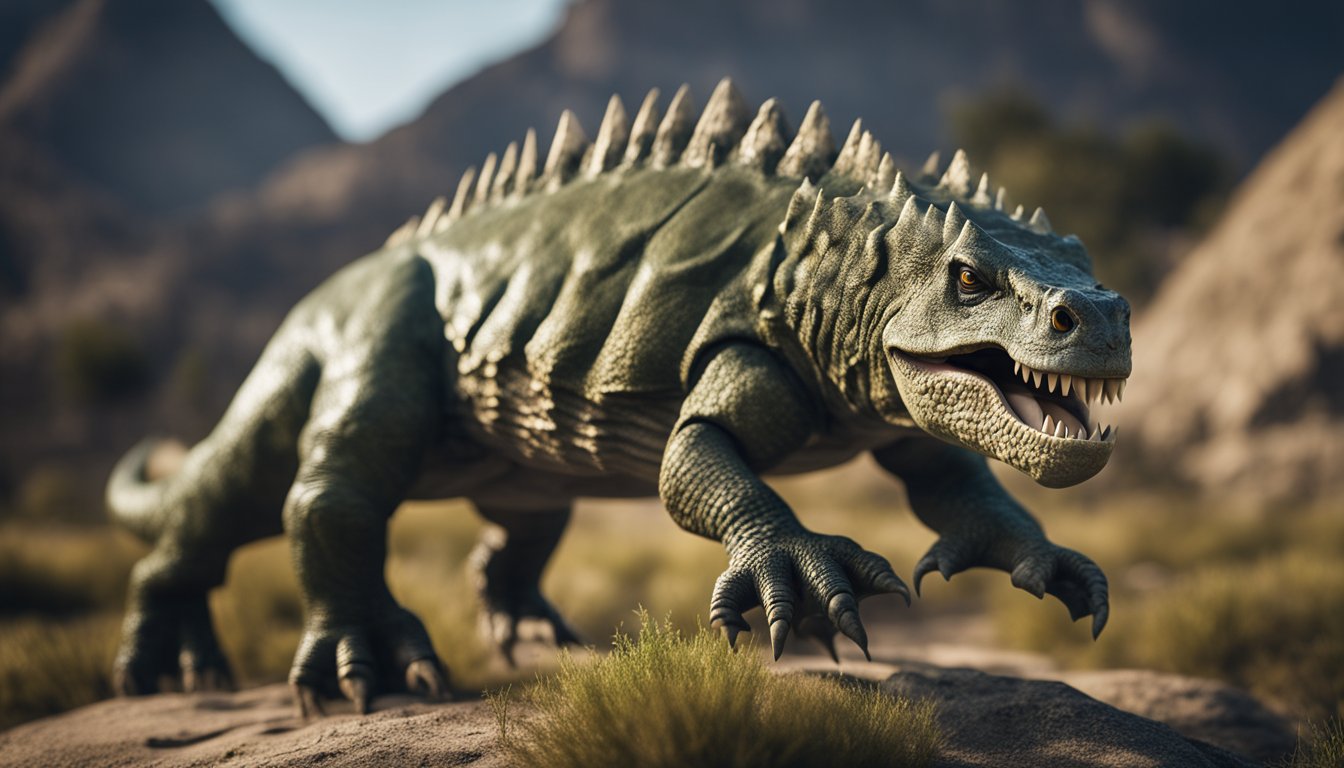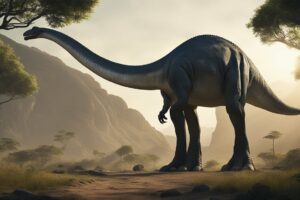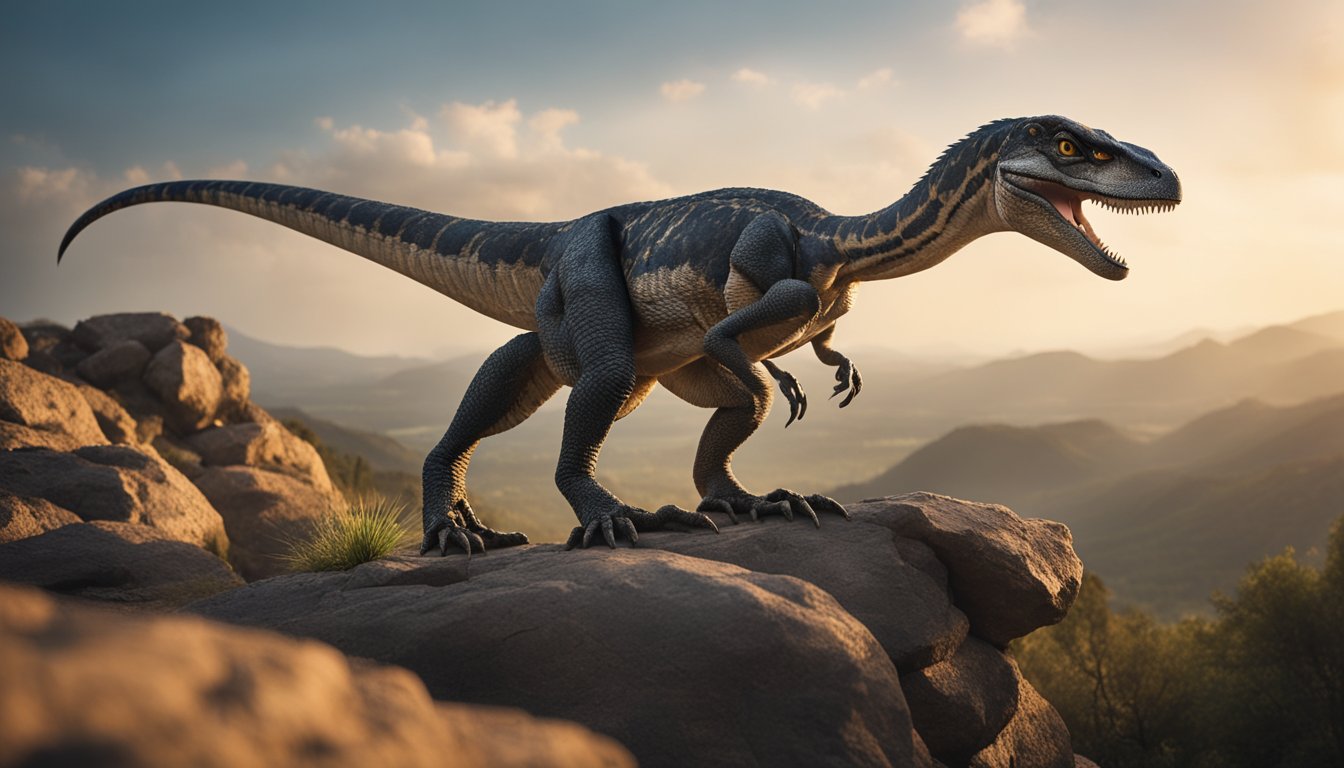Dinosaurs may have ruled the earth for millions of years, but they were not the only prehistoric predators to roam the planet.
Meet Dinogorgon, a fearsome gorgonopsid therapsid that lived during the Late Permian period in Southern Africa.
Despite its relatively small size compared to other gorgonopsids, Dinogorgon was a formidable predator that lurked in the shadows, waiting to pounce on unsuspecting prey.

Unraveling the secrets of Dinogorgon has been a fascinating journey for paleontologists.
By studying the fossil record, scientists have pieced together the anatomy, behavior, and ecology of this enigmatic creature.
They have discovered that Dinogorgon had a powerful bite, sharp teeth, and a keen sense of smell that helped it hunt and kill its prey.
They have also found evidence that suggests Dinogorgon may have been a social animal that lived in groups, much like modern-day lions.
Despite the wealth of knowledge we have gained about Dinogorgon, there is still much we don’t know about this prehistoric predator.
But one thing is certain: Dinogorgon’s legacy lives on, inspiring us to learn more about the natural world and the amazing creatures that once roamed the earth.
Unearthing the Dinogorgon

Fossil Discoveries in Africa
The story of Dinogorgon begins with the discovery of fossils in South Africa’s Karoo region.
The Karoo region is known for its rich deposits of fossils that date back to the Permian period, which lasted from about 299 to 251 million years ago.
Paleontologists have been studying these fossils for decades, and they have uncovered a wealth of information about the prehistoric world.
One of the most fascinating discoveries in the Karoo region is the Dinogorgon oudebergensis, a gorgonopsid therapsid that lived during the late Permian.
Fossils of the Dinogorgon have been found in various locations in South Africa, and they provide valuable insights into the life of this prehistoric predator.
Dinogorgon and the Permian Period
During the Permian period, the Earth was a very different place than it is today. The climate was much drier, and the continents were arranged differently.
The Karoo region was located near the equator, and it was covered by vast deserts and grasslands.
The Dinogorgon was a mid-sized gorgonopsid that roamed the Karoo region during the late Permian.
It was a fierce predator that had sharp teeth and powerful jaws.
The Dinogorgon was a close relative of the famous Lycaenops, another gorgonopsid that lived during the same period.
Paleontologists have learned a great deal about the Dinogorgon from the fossils that have been discovered.
They know that the Dinogorgon was about two meters long on average, and that it was a skilled hunter that preyed on smaller animals.
They also know that the Dinogorgon had a unique skull structure that allowed it to bite with tremendous force.
In conclusion, the discovery of fossils in the Karoo region has provided valuable insights into the prehistoric world, and the Dinogorgon is just one of the many fascinating creatures that lived during the Permian period.
Anatomy of a Predator

Dinogorgon, a prehistoric predator from the Late Permian period, was a mid-sized gorgonopsid therapsid that lived in Southern Africa.
Its anatomy and morphology were well-suited for hunting and capturing prey.
Skull Structure and Hunting Tactics
Dinogorgon had a large skull with powerful jaws and sharp teeth. Its skull was similar to that of modern-day carnivores such as cheetahs and velociraptors.
The skull had a large sagittal crest, which was a bony ridge on the top of the skull that served as an attachment site for powerful jaw muscles.
The sagittal crest allowed Dinogorgon to bite and hold onto its prey with great force.
Dinogorgon’s hunting tactics were similar to those of modern-day predators.
It would stalk its prey from a distance, using its keen senses to track and locate its target.
Once it was in range, it would pounce on its prey with great speed and force, using its powerful jaws to bite and hold onto its target.
Comparing Limbs and Locomotion
Dinogorgon had four limbs that were adapted for different functions.
Its front limbs were shorter and more robust than its hind limbs, which were longer and more slender.
The front limbs were used for grasping and holding onto prey, while the hind limbs were used for running and chasing.
Dinogorgon’s locomotion was similar to that of modern-day predators. It was a fast runner, capable of reaching speeds of up to 30 miles per hour.
Its long, slender hind limbs allowed it to cover great distances quickly, while its short, robust front limbs helped it maintain balance and control while running.
In conclusion, Dinogorgon was a formidable predator with a unique anatomy and morphology that made it well-suited for hunting and capturing prey.
Its large skull and powerful jaws, combined with its fast running speed and keen senses, made it a formidable opponent for any prey that crossed its path.
The Dinogorgon’s World

Habitat and Prey
Dinogorgon was a prehistoric predator that roamed the earth during the Late Permian period, about 260 million years ago.
It lived in Southern Africa, specifically in present-day Tanzania.
The habitat of Dinogorgon was characterized by floodplains and river deltas, where it hunted for prey.
Dinogorgon was a carnivore that preyed on a wide variety of animals, including fish and lizards.
With its powerful jaws and sharp teeth, it was a formidable predator that could take down even the largest prey.
Its hunting strategy was to ambush its prey, using its powerful legs to quickly close in for the kill.
Paleoecology and Community Dynamics
Dinogorgon was part of a diverse community of animals that lived during the Late Permian period.
This period was characterized by a warm and humid climate, and the presence of a wide variety of plants and animals.
Dinogorgon was one of the top predators in this ecosystem, and its presence had a significant impact on the community dynamics.
The Late Permian period was also a time of great ecological change, with the Permian-Triassic extinction event marking the end of the Permian period.
This event was one of the most significant mass extinctions in Earth’s history, and it had a profound impact on the ecosystems of the time.
Overall, Dinogorgon was a fascinating and fearsome predator that played an important role in the Late Permian ecosystem.
Its habitat and hunting strategies were well-suited to its environment, and its presence had a significant impact on the community dynamics of the time.
Extinction and Legacy
The Great Dying
Dinogorgon, like many other prehistoric creatures, met its end during the Great Dying, the most catastrophic mass extinction event in Earth’s history.
This event occurred approximately 252 million years ago, wiping out about 90% of all plant and animal species on the planet.
The cause of this extinction event is still a matter of debate among scientists, but some theories suggest that it was triggered by massive volcanic eruptions, asteroid impacts, or a combination of both.
Dinogorgon was not the only victim of this extinction event.
Many other prehistoric creatures, including the dominant therapsids, were also wiped out, paving the way for the rise of the dinosaurs.
However, some scientists believe that some therapsids, including the ancestors of mammals, survived the extinction event and eventually gave rise to modern mammals.
From Dinogorgon to Dinosaurs and Beyond
Despite its relatively short existence, Dinogorgon left a lasting legacy in the evolution of vertebrates.
As a member of the therapsid group, Dinogorgon was one of the earliest mammal-like reptiles, and its anatomy and behavior provide important clues about the evolution of mammals.
Dinogorgon was a predator, and its saber-like teeth and powerful jaws made it a formidable hunter.
Its closest relatives, the gorgonopsids, were among the first predators to evolve on land, and their success paved the way for the rise of the dinosaurs and other reptiles.
Today, Dinogorgon and its relatives are long gone, but their legacy lives on in the form of modern mammals, including humans.
By studying the fossils of these prehistoric predators, scientists can gain insights into the evolution of vertebrates and the natural history of our planet.
Did you know that Dinogorgon’s closest relative, Lycaenops, was also a therapsid predator that lived during the Late Permian period?
Frequently Asked Questions

What kind of diet sustained the mighty Dinogorgon during its reign in prehistoric times?
Dinogorgon was a carnivorous predator that fed on other animals.
Its sharp teeth were ideal for tearing through flesh, and its powerful jaws allowed it to deliver a fatal bite.
Dinogorgon’s diet consisted mainly of smaller reptiles and amphibians, but it could also take down larger prey such as herbivorous therapsids.
How does the Gorgonopsid compare in size to other known prehistoric creatures?
Gorgonopsids were among the top predators of their time, but they were not the largest creatures around.
Dinosaurs such as the Brachiosaurus and the Tyrannosaurus Rex were much larger, while other therapsids such as the Moschops and the Estemmenosuchus were bulkier.
However, Gorgonopsids were still formidable hunters, and their sharp teeth and powerful jaws made them a force to be reckoned with.
Can you uncover the mysteries behind the fossils of the Gorgonopsid and what they tell us about the past?
The fossils of Gorgonopsids provide a wealth of information about life in the late Permian period, over 250 million years ago.
By studying these fossils, scientists have been able to learn about the anatomy, behavior, and ecology of these fascinating creatures.
For example, the discovery of Gorgonopsid fossils in different locations around the world has helped scientists piece together the distribution of landmasses during the Permian period.
What characteristics link the Gorgonopsid and Diictodon to mammals rather than to dinosaurs or modern reptiles?
Gorgonopsids and Diictodons are both classified as therapsids, a group of reptiles that share many characteristics with mammals.
Some of these characteristics include a more advanced jaw structure, a secondary palate, and a more efficient respiratory system.
These traits allowed therapsids to be more effective predators and to thrive in a wider range of environments than their reptilian ancestors.
Which creature holds the title of the largest Gorgonopsid ever discovered?
The title of largest Gorgonopsid goes to Inostrancevia, a massive predator that lived during the late Permian period.
Inostrancevia was over 4 meters long and weighed over 500 kg, making it one of the largest carnivores of its time.
In the grand timeline of predatory beasts, how did the Dinogorgon measure up to its contemporaries in terms of size and strength?
Dinogorgon was a mid-sized Gorgonopsid, measuring around 2 meters in length.
While it was not the largest or strongest predator of its time, it was still a formidable hunter with sharp teeth and powerful jaws.
Dinogorgon’s success as a predator was likely due to its agility and speed, which allowed it to catch smaller prey and avoid larger predators.





